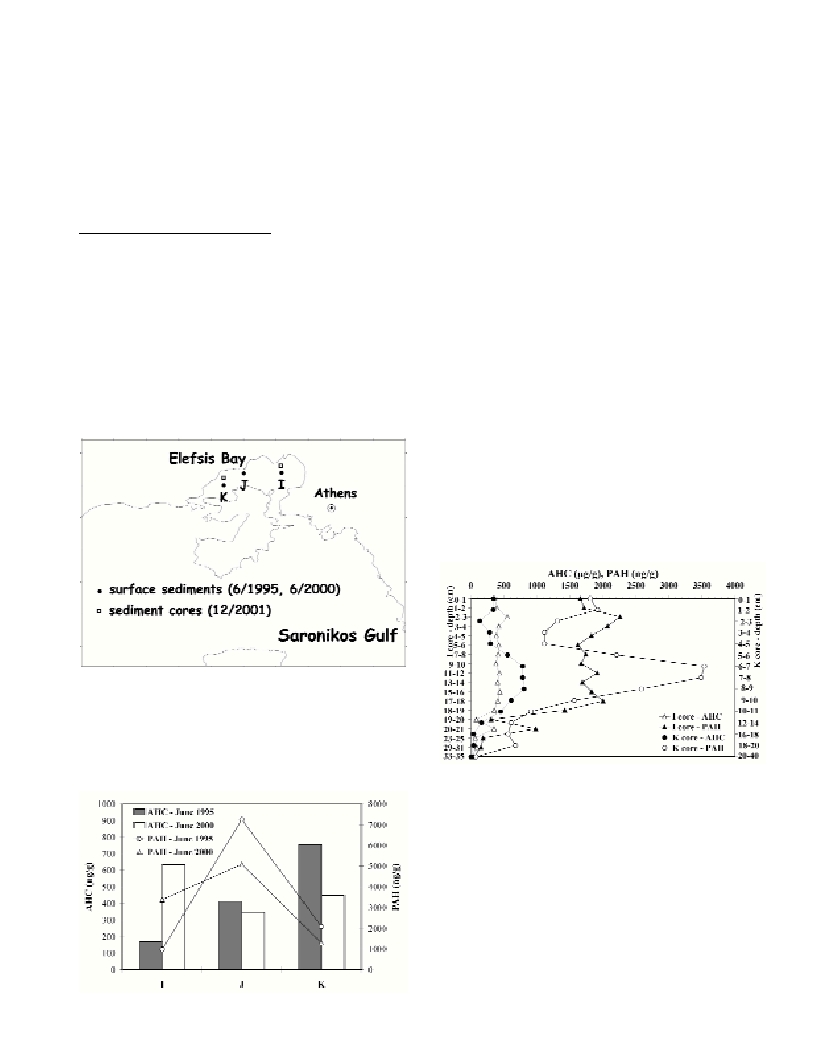Rapp. Comm. int. Mer Médit., 37,2004
244
DISTRIBUTION AND ORIGIN OF HYDROCARBONS IN SEDIMENTS FROM ELEFSIS BAY,
GREECE (EASTERN MEDITERRANEAN)
E. Sklivagou
1*
, I. Hatzianestis
1
, N. Rori
2
, F. Rigas
2
1
Hellenic Centre for Marine Research, Mavro Lithari, 190 13 Anavyssos, Greece - * jenny@ncmr.gr
2. School of Chemical Engineering, National Technical University of Athens. 15700 Athens, Greece.
Abstract
Hydrocarbons were studied in surface sediments and sediment cores collected from the Elefsis Bay. Aliphatic hydrocarbon concentrations
(AHC) in surface sediments ranged from 170 to 753 µg/g, while polycyclic aromatic hydrocarbon (PAH) values varied between 981 and
7255 ng/g. Concentrations in the western core remained high for both AHC and PAH till to 10 cm depth. In the eastern core, the high
hydrocarbon values persist to 19 cm depth.
Keywords: sediments, petroleum, PAH
Introduction
Elefsis Bay is an almost enclosed embayment, which is situated in
the northern Saronikos gulf, in central Greece. The Bay receives
industrial effluents and domestic wastes, which generate severe
ecological stresses in the area, resulting in almost anoxic conditions
during summer.
The aim of this work is to study the horizontal and vertical profiles
of AHC and PAH in Elefsis Bay sediments, in order to assess their
levels and sources and to investigate the history of their inputs.
Materials and methods
Surface sediment samples (0-2 cm) were collected from three
stations during June 1995 and June 2000. In addition, two sediment
cores were collected in December 2001 (Fig. 1). The AHC and PAH
were determined by gas chromatography / mass spectrometry [1].
Fig. 1. The sediment sampling locations.
Results and discussion
Surface sediments
The concentrations of aliphatic hydrocarbons (AHC) found in
Elefsis Bay sediments during the two sampling periods ranged between
170 and 753 µg/g (Fig. 2). These AHC values clearly indicate that the
area suffers from substantial petroleum contamination [2].
Furthermore, the ratio unresolved/resolved compounds (U/R), which is
widely used in order to identify the origin of the hydrocarbons, gave
values indicative of significant petroleum contamination (U/R= 17-46).
Twenty-four PAH compounds were determined in this study,
comprising parent compounds with two to six aromatic rings,
dibenzothiophene, retene and the alkylated products of phenanthrene
and dibenzothiophene. Total PAH concentrations in Elefsis Bay
sediments ranged between 981 and 7255 ng/g (Fig. 2), indicating a
high degree of pollution in comparison with other Greek areas [2]. In
the PAH mixture, the compounds with four or more aromatic rings
and mainly, ?uoranthene and pyrene, were dominant in all cases.
These compounds are known to be of pyrolytic origin.
Sediment cores
AHC concentrations in the western core (K core) ranged between 4
and 805 µg/g (Fig. 3). The high AHC values remained almost constant
down to 10 cm depth and the maximum value was recorded in the 8-
9 cm layer. On the other hand, PAH concentrations ranged from 79 to
3536 ng/g (Fig. 3). The vertical profile of PAH values showed
pronounced maxima in the layers 6-7 and 7-8 cm.
In the eastern core (I core), AHC concentrations were observed in
the range of 18 – 551 µg/g, while PAH values varied between 44 and
2259 ng/g (Fig. 3). The vertical distribution for both parameters was
relatively uniform till to 19 cm depth and the maximum values were
recorded in the 2-3 cm layer.
Fig. 3. Vertical profiles of AHC and PAH in the two sediment cores.
References
1-UNEP/IOC/IAEA, 1992. Determination of petroleum hydrocarbons in
sediments. Reference Methods for Marine Pollution Studies, No 20,
UNEP
2-Hatzianestis I., Sklivagou E. and Georgakopoulou E., 2001.
Hydrocarbons, pesticides and PCBs in sediments from Thermaikos gulf.
Fres. Environ.Bull., 10(1): 63-68.
Fig. 2. AHC and PAH concentrations in the surface sediments.

